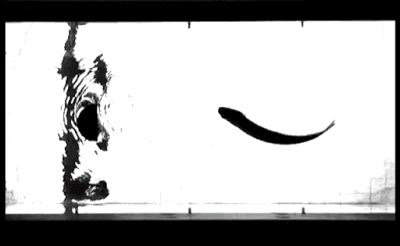Resonance is a funny creature, as Dianna discovered when she tried to sing a rising scale through a tube. At certain notes, everyone who attempted to do it had their voices crack. Tracking down the source of the mystery means digging into what exactly resonance is and what the differences are between driving a system just before, at, and after resonance. Check out the video for the full acoustic story. (Video credit: Physics Girl)
Tag: resonance

Resonating on a Bounce
When we think of resonance, we often think of it in simple terms: hit the one right note, and the wine glass will shatter. But resonance isn’t always about a one-to-one ratio between a driving frequency and the resonating system. Especially in fluid dynamics, we often see responses that occur at other, related frequencies.
One of the simplest places to see this is with a droplet bouncing on a bath of fluid. Above you see a liquid metal droplet bouncing on a bath of the same metal. At low amplitude, the pool surface moves at the driving frequency and a droplet bounces simply upon that surface, with one bounce per oscillation. Increase the amplitude, though, and the droplet’s bounce changes. It bounces twice – one large bounce and one small bounce – in the time it takes for the pool surface to go through one cycle. This is called period doubling because the bouncing occurs at twice the driving frequency.
Turn the amplitude up further, and the system undergoes another change. Faraday waves form on the surface. They resonate at half the driving frequency, and a droplet’s bouncing will sync up with the waves. That means the droplet returns to a one-to-one bounce with the waves, but the waves themselves are no longer reacting at the driving frequency. It’s this kind of complexity that makes fluid systems fertile grounds for studying paths toward chaos. (Image and research credit: X. Zhao et al.)

Levitating with Sound
Sound can manipulate fluids in fascinating ways, from levitation to vibration. Here researchers use sound to levitate and manipulate droplets and turn them into bubbles. Increasing the acoustic pressure on the levitating droplet flattens it, then slowly causes the drop to buckle. When the buckled film encloses a critical volume, the sound waves resonate inside it. That causes a big jump in acoustic pressure, which makes the drop snap closed into a bubble. (Image and research credit: D. Zang et al.; via Science News; submitted by Kam-Yung Soh)

The Mystery of Carnegie Hall’s Sound
For nearly a century, the acoustics of Carnegie Hall were touted as among the very best in the world. But after a much-needed renovation in 1986, musicians and critics felt the magic of the old sound had been lost. In this video, Gizmodo explores the mystery of what changed. Was it a hole in the ceiling? The curtains that had been removed?
Eventually, a second renovation – this time for warping of the stage floor – revealed the likely culprit. Concrete had been installed to reinforce the stage in the first renovation, and this changed the stage’s resonance. Previously, instruments like the bass had caused the wooden floor to vibrate, which amplified their sound. The concrete damped that vibration, cutting out a key ingredient in Carnegie’s acoustics. When the second renovation restored the all-wooden stage, suddenly the venerable concert hall had its sound back. (Video credit: Gizmodo)

The Sound of Bubbles
When you enjoy the sound of a babbling stream on a hike, what you’re actually hearing is bubbling. Air bubbles caught in the water resonate at a frequency that depends on their size. In fact, you can use a hydrophone – basically an underwater microphone – to listen to these bubbles and learn about them. Researchers recently did exactly that with glasses of sparkling wine. By listening to the bubbles and applying a simple physical model, the researchers could characterize differences in two brands of sparkling wine, including just how bubbly they were and what size their typical bubbles are. They hope eventually to develop acoustic techniques that can monitor quality control for sparkling wines and other carbonated beverages. (Image credit: J. Kääriäinen; research credit: K. Spratt et al.; submitted by Kam-Yung Soh)

A Star Drop
There are many ways to make a droplet oscillate in a star-shape – like vibrating its surface or using acoustic waves to excite it – but these methods involve externally forcing the droplet’s oscillation. Leidenfrost drops – liquids levitating on a film of their own vapor caused by the extremely hot surface below – turn themselves into stars. It all starts with the constant evaporation driven by the heat below. This creates a thin, fast-moving layer of vapor flowing beneath the drop. That vapor shears the drop, causing capillary waves – essentially ripples – that travel through the drop in a characteristic way. Those ripples in turn cause pressure oscillations in the vapor layer, alternately squeezing and releasing it. Feedback from the vapor layer then drives the droplet into star-shaped oscillations. Under the right conditions, water drops can form stars with as many as 13 points! (Image and research credit: X. Ma and J. Burton, source)

The Swimming of a Dead Fish
When I was a child, my father would take me trout fishing, and I spent hours marveling from the riverbank at the trouts’ ability to, seemingly effortlessly, hold their position in the fast-moving water. As it turns out, those trout really were swimming effortlessly, in a manner demonstrated above. The fish you see here swimming behind the obstacle is dead. There’s nothing powering it, except the energy its flexible body can extract from the flow around it.
The obstacle sheds a wake of alternating vortices into the flow, and when the fish is properly positioned in that wake, the vortices themselves flex the fish’s body such that its head and its tail point in different directions. Under just the right conditions, there’s actually a resonance between the vortices and the fish’s body that generates enough thrust to overcome the fish’s drag. This means the fish can actually swim upstream without expending any energy of its own! The researchers came across this entirely by accident, and one of the questions that remains is how the trout is able to sense its surroundings well enough to intentionally take advantage of the effect. (Image and research credit: D. Beal et al.; via PhysicsBuzz; submitted by Kam-Yung Soh)

Chinese Spouting Bowl Physics
In their newest video, the Slow Mo Guys recreated one of my favorite effects: vibration-driven droplet ejection. For this, they use a Chinese spouting bowl, which has handles that the player rubs after partially filling the bowl with water. By rubbing, a user excites a vibrational mode in the bowl. Watch the GIFs above and you can actually see the bowl deforming steadily back and forth. This is the fundamental mode, and it’s the same kind of vibration you’d get from, say, ringing a bell.
Without a high-speed camera, the bowl’s vibration is pretty hard to see, but it’s readily apparent from the water’s behavior in the bowl. In the video, Gav and Dan comment that the ripples (actually Faraday waves) on the water always start from the same four spots. That’s a direct result of the bowl’s movement; we see the waves starting from the points where the bowl is moving the most, the antinodes. In theory, at least, you could see different generation points if you manage to excite one of the bowl’s higher harmonics. The best part, of course, is that, once the vibration has reached a high enough amplitude, the droplets spontaneously start jumping from the water surface! (Video and image credits: The Slow Mo Guys; submitted by effyeah-artandfilm)

Songs in Soap
There are many beautiful ways to visualize sound and music – Chris Stanford’s fantastic “Cymatics” music video comes to mind – but this is one I haven’t seen. This visualization uses a soap film on the end of an open tube with music playing from the other end. You can see the set-up here. The result is a fascinating interplay of acoustics, fluid dynamics, and optics. As sound travels through the tube, certain frequencies resonant, vibrating the soap film with a standing wave pattern (3:20). At the same time, interference between light waves reflecting off the front and back of the soap film create vibrant colors that show the film’s thickness and flow.
When the frequency and amplitude are just right, the sound excites counter-rotating vortex pairs in the film (0:05), mixing areas of different thicknesses. With just a single note, the vortex pairs appear and disappear, but with the music, their disappearance comes from the changing tones. Watching the patterns shift as the film drains and the black areas grow is pretty fascinating, but one of the coolest behaviors is how the acoustic interactions are actually able to replenish the draining film (2:15). Because the tube was dipped in soap solution, some fluid is still inside the tube, lining the walls. With the right acoustic forcing, that fresh fluid actually gets driven into the soap film, thickening it.
There are several more videos with different songs here – “Carmen Bizet” is particularly neat – as well as a short article summarizing the relevant physics for those who are interested. (Video and research credit: C. Gaulon et al.; more videos here)

The Tibetan Singing Bowl
Rubbing a Tibetan singing bowl creates sound and a spray of droplets inside the container. But the reverse works, too! Instead of rubbing the bowl, one can project sound at it to make the droplets dance. In the video above, the speaker plays a sinusoidal wave at a frequency that resonates with the bowl. It activates the most basic vibrations in the bowl, making it bulge slightly front-to-back and then side-to-side. This is called the fundamental vibrational mode. The bowl doesn’t change shape enough to see by eye, but you can tell where the bowl is flexing the most – at the four points where the droplets are ejected! The larger vibrations there are what create the spray of droplets. (Video credit: D. Terwagne)








